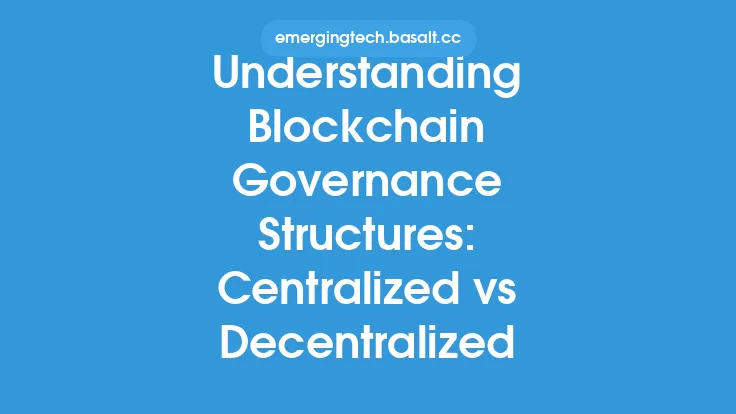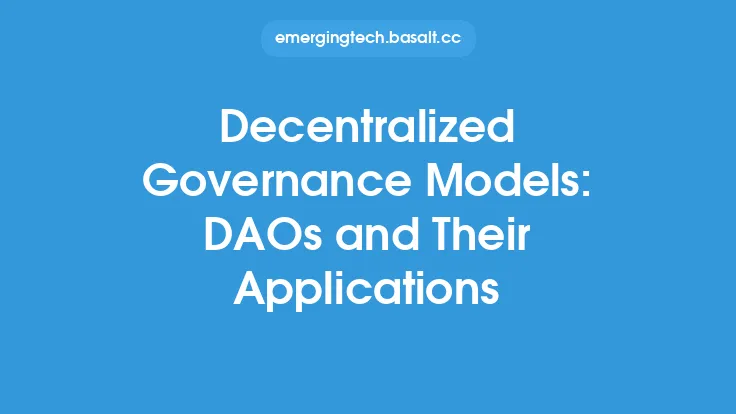The concept of blockchain governance has become increasingly important as the technology continues to evolve and expand into various industries. At its core, blockchain governance refers to the set of rules, processes, and protocols that govern the operation of a blockchain network. It encompasses the decision-making processes, conflict resolution mechanisms, and power structures that shape the development and growth of the network. In this article, we will delve into the principles and models of blockchain governance, exploring the fundamental concepts and frameworks that underpin this critical aspect of blockchain technology.
Principles of Blockchain Governance
Blockchain governance is built on several key principles that ensure the integrity, security, and transparency of the network. These principles include decentralization, autonomy, transparency, accountability, and inclusivity. Decentralization refers to the distribution of power and decision-making authority among network participants, rather than being controlled by a single entity. Autonomy refers to the ability of network participants to make decisions and take actions without external interference. Transparency ensures that all network activities and decisions are visible and accessible to all participants. Accountability holds network participants responsible for their actions and decisions. Inclusivity ensures that all stakeholders have a voice and are represented in the decision-making process.
Models of Blockchain Governance
There are several models of blockchain governance, each with its strengths and weaknesses. The most common models include on-chain governance, off-chain governance, and hybrid governance. On-chain governance refers to the use of smart contracts and blockchain-based protocols to manage and govern the network. Off-chain governance, on the other hand, relies on external mechanisms, such as voting systems and community forums, to make decisions and govern the network. Hybrid governance models combine elements of both on-chain and off-chain governance, offering a more flexible and adaptive approach to network management.
Key Components of Blockchain Governance
Effective blockchain governance requires several key components, including a clear governance structure, well-defined rules and protocols, and a robust decision-making process. A clear governance structure outlines the roles and responsibilities of network participants, as well as the decision-making processes and power structures. Well-defined rules and protocols ensure that the network operates consistently and predictably, while a robust decision-making process enables network participants to make informed and collective decisions. Additionally, a strong governance framework should include mechanisms for conflict resolution, dispute settlement, and network maintenance.
Benefits of Effective Blockchain Governance
Effective blockchain governance offers several benefits, including increased security, improved scalability, and enhanced transparency. By establishing clear rules and protocols, blockchain governance helps to prevent malicious activities and ensure the integrity of the network. Improved scalability enables the network to grow and adapt to changing demands, while enhanced transparency builds trust and confidence among network participants. Furthermore, effective governance helps to promote cooperation and collaboration among stakeholders, fostering a sense of community and shared purpose.
Challenges and Limitations of Blockchain Governance
Despite its importance, blockchain governance faces several challenges and limitations. One of the main challenges is balancing decentralization with the need for effective decision-making and network management. Overly decentralized systems can be slow and cumbersome, while overly centralized systems can be vulnerable to abuse and exploitation. Another challenge is ensuring the representation and participation of all stakeholders, particularly in large and diverse networks. Additionally, blockchain governance must navigate the complexities of regulatory compliance, intellectual property, and cybersecurity, all of which can impact the development and growth of the network.
Conclusion
In conclusion, blockchain governance is a critical aspect of blockchain technology, encompassing the rules, processes, and protocols that govern the operation of a blockchain network. By understanding the principles and models of blockchain governance, we can better appreciate the complexities and challenges of this emerging field. Effective blockchain governance offers several benefits, including increased security, improved scalability, and enhanced transparency, but it also faces several challenges and limitations. As the blockchain ecosystem continues to evolve and expand, the development of robust and adaptive governance frameworks will be essential for ensuring the long-term success and sustainability of these networks.





